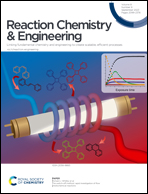Relationship between feeding strategies and nitrogen sources in platform chemical bio-based 2,3-butanediol production in fed-batch fermentation†
Abstract
Bio-based 2,3-BDO production can be improved through fed-batch fermentation and nutritional control. This study investigated the relationship between different feeding profiles and nitrogen sources for high-yield 2,3-BDO production by Paenibacillus peoriae NRRL BD-62. About 28.6 g L−1 2,3-BDO was achieved in constant fed-batch fermentation at 1.3 mL h−1 using glucose and yeast extract (YE) at an initial C/N = 8.5 g g−1, while a reduction of 44% was found at an initial C/N = 18.5 g g−1. In contrast, no statistical differences were observed in one-pulse feeding assays under the same conditions. Both feeding strategies achieved a high 2,3-BDO yield of approximately 80% of the theoretical value. To reduce costs, YE was replaced with NH4Cl, and an exponential fed-batch fermentation was investigated, resulting in almost a 76% higher 2,3-BDO titer (∼10.7 g L−1) and about a 1.2-fold higher 2,3-BDO yield (0.39 g g−1) at μ = 0.17 h−1 compared to pulse feeding at μ = 0.24 h−1, both at an initial C/N = 8.5 g g−1. However, residual glucose accumulation was observed, intensified by the nutritional limitation of NH4Cl. Therefore, the nitrogen supply was the main limiting factor for the high-yield bio-based 2,3-BDO production, which must be controlled for planning, developing, and implementing large-scale fed-batch fermentations.



 Please wait while we load your content...
Please wait while we load your content...